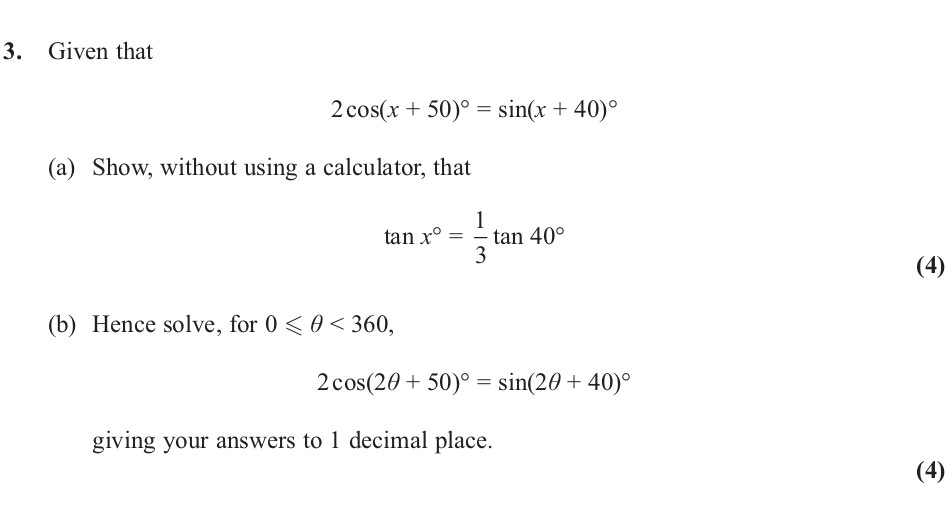Photo AI
Given that $2\cos(x + 50^\circ) = \sin(x + 40^\circ)$ (a) Show, without using a calculator, that tan x^\circ = \frac{1}{3} \tan 40^\circ (b) Hence solve, for $0 \leq \theta < 360$, $2\cos(2\theta + 50^\circ) = \sin(2\theta + 40^\circ)$ giving your answers to 1 decimal place. - Edexcel - A-Level Maths Pure - Question 5 - 2013 - Paper 7
Question 5

Given that $2\cos(x + 50^\circ) = \sin(x + 40^\circ)$ (a) Show, without using a calculator, that tan x^\circ = \frac{1}{3} \tan 40^\circ (b) Hence solve, for $0 ... show full transcript
Worked Solution & Example Answer:Given that $2\cos(x + 50^\circ) = \sin(x + 40^\circ)$ (a) Show, without using a calculator, that tan x^\circ = \frac{1}{3} \tan 40^\circ (b) Hence solve, for $0 \leq \theta < 360$, $2\cos(2\theta + 50^\circ) = \sin(2\theta + 40^\circ)$ giving your answers to 1 decimal place. - Edexcel - A-Level Maths Pure - Question 5 - 2013 - Paper 7
Step 1
Show, without using a calculator, that tan x° = 1/3 tan 40°
Answer
To show that tan x^\circ = \frac{1}{3} \tan 40^\circ, we start from the given equation:
Using the sine identity, we can express in terms of cosine:
Thus, substituting this back, we have:
Next, apply the cosine of an angle difference:
So,
Equating the two sides gives:
Dividing both sides by \cos(x + 50^\circ) will give:
From this equation, if you isolate for by assuming the right triangles are established, you can simplify this to conclude with that:
Step 2
Hence solve, for 0 ≤ θ < 360, 2cos(2θ + 50°) = sin(2θ + 40°)
Answer
To solve the equation
Using the same sine identity as before: \sin(2\theta + 40^\circ) = \sin(40^\circ + 90^\circ - (90^\circ + 2\theta)) Which simplifies to:
Thus, equating this gives:
Dividing by \cos(2\theta + 50^\circ) yields:
Since that is not possible for trigonometric identities, we look for specific values:
Thus, set these two values to solve for :
- The solutions can be written as: 2\theta + 50^\circ = k360^\circ$$
Substituting shows:
- For the first equation, it will yield:
And similarly for checking up to 360, you can show and discover further valid angles like , and check against the periodic nature of sine and cosine. The final valid entries here will produce answers rounded to 1 decimal place as requested.
